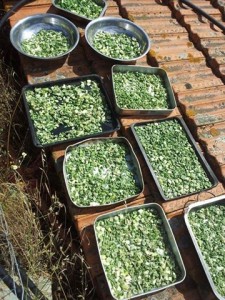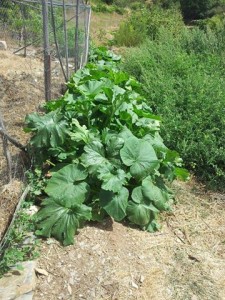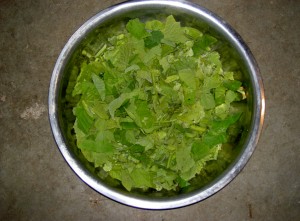I wrote this back in 2014. Spending some time away from home reliant on supermarket veggies brought it to mind again.
If you’ve gone to all the time and trouble to grow something delicious and nutritious, you’ll want to make the most of it. Well, that’s the way we look at it anyway! We don’t believe in waste and, although our animals will gleefully process any vegetable scraps we produce, we would still rather eat them ourselves where possible. A great example of this is the fruit scrap vinegar we’ve started producing, but what about vegetables?
In most cases the vegetables offered in the supermarket have been shorn of all their greenery to lengthen their shelf life, and I’m sure that’s why so many people just don’t realise that many vegetables have more edible parts that we’re generally offered.
Take onions for instance. The green leaves are delicious, either raw in salads or cooked. They’re so good that we store our onion harvest minus the greens, so that we can dehydrate those for use over the winter.
Carrots too have tasty leaves. They’re a bit tough so best chopped into cooked dishes very finely. Again, they dehydrate nicely so preserving a glut when the crop is harvested is easy.
Pumpkin and squash leaves and buds are tasty steamed with a little chilli and lemon. Just the small and fresh ones though, we suggest the goats might appreciate the tougher ones more than people! And the flowers are a delicacy of course, although do remember to remove the stamens as they are incredibly bitter. Try stuffing them with ricotta and cashew purée then frying in a tempura batter if you’re feeling exotic, but if you’ve more simple tastes (or better things to do!) then just chuck them in the final simmer of your soup or on top of a pizza.
Pumpkins and squashes (left) produce huge amounts of greenery. The young leaves and buds (right) make a delicious lightly squash flavoured green vegetable.
Beetroot leaves of course can be eaten raw or cooked, we’re used to seeing the young leaves in pre-prepared bagged salads. The larger leaves are equally good, either finely chopped raw or cooked. Beware interesting coloured soups though! Did you know that beetroot stalks are delicious lightly lacto-fermented? Don’t waste a thing! Just chop them into lengths and fully submerge in salted water for a week or so to taste. The fermented pieces are tasty in a mixed salad, and a funky colour too.
Pinch off the tops of pea and bean vines for a tasty extra. Turnip leaves are commonly served as a spinach type dish here in Portugal, but rarely eaten in the UK. Radish leaves can be treated the same. Why throw away half the plant?! Broccoli stalk is yummy chopped and sautéed in butter. The leaves are thicker than cabbage, but treat the same. Cauliflower too. You can harvest about a third of the greens from your sweet potato crop and treat as spinach without hurting the crop of roots.
When planning your garden, maximise your yield by planting things with more than one edible yield. Compare beetroot and parsnip for example, two root crops taking up approximately the same amount of space in the bed. The beetroot can be eaten in it’s entirety (the leaves can even be treated as a cut and come again crop without damaging the root crop if you’re not over greedy), whereas the luxuriant greens of the parsnip go to waste as we can only enjoy the root. I’m not suggesting that we forego parsnips entirely! Variety is the spice of life! But it’s a little something else to consider.
It’s worth my pointing out that we have compost loos and ALL our waste finds it’s way back to the land eventually. Our compost heaps don’t suffer for the lack of veg trimmings!
I’m sure there are many more examples than I’ve mentioned here. Please share in the comments below if you can think of any.




Leave a Reply